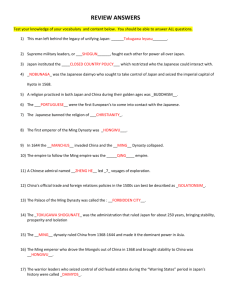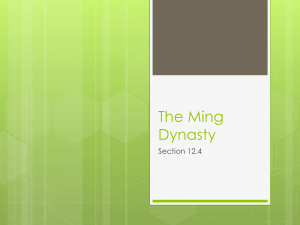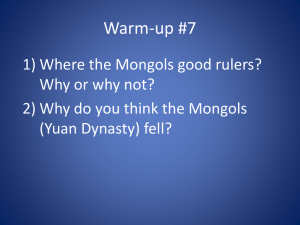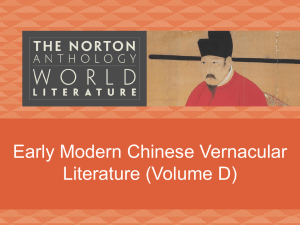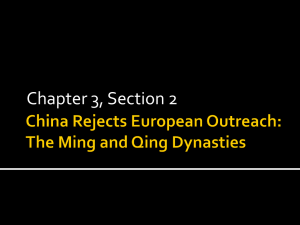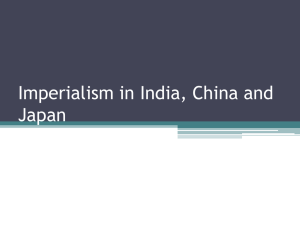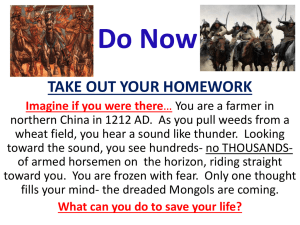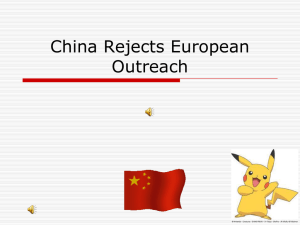Ming Dynasty
advertisement
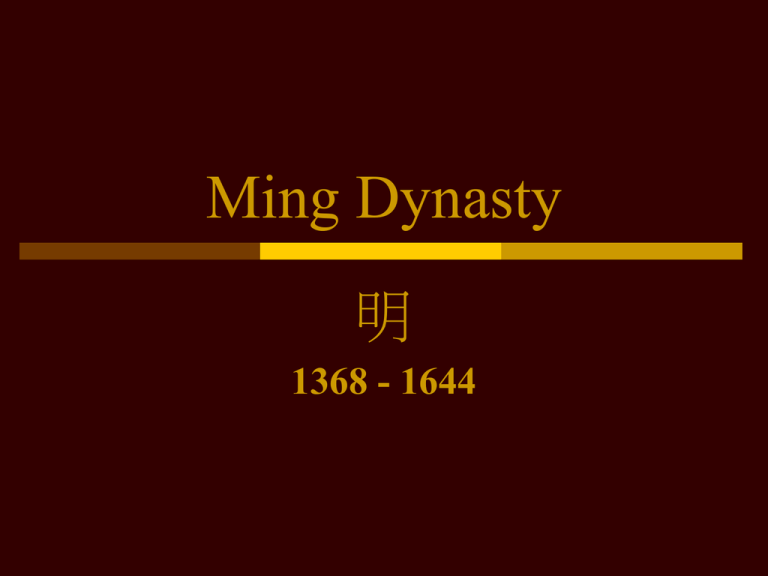
Ming Dynasty 明 1368 - 1644 Overview Last Han Chinese Dynasty Aborted attempts at overseas expansion Beginning of sustained contact with the West Increasingly autocratic rule Factionalism, Eunuchs, and dynastic decline Establishing the Ming Zhu Yuanzhang (1328 – 1399) Hongwu (ruled 1368 – 1399) Mendicant monk Joined an uprising against the Mongols Religiously inspired rebel groups 1351 – 1368 widespread rebellions against the Mongols Joined Leadership of Red Turbans Captured Nanjing and obtained Confucian advisors 1368 took dynastic title and invoked the Mandate of Heaven Zhu Yuanzhang - Hongwu Without his make-up? Hongwu (1368 – 1399) 1368 – 1380 consolidate control and campaign against the Mongols 1380 Turning point in the early Ming Major political purges of former supporters Revamped government Emperor is the sole coordinator of top echelon administration Eliminated the Secretariat, Censorate, and Chief Military Commission 1384 Civil Service Examinations reinstituted Rural Reforms Lijia system – sets of 110 households manage local tax system Yongle Emperor (r. 1402-24) Son of Hongwu Usurped throne from his nephew Moved capital from Nanjing to Beijing Expand territory into Manchuria and Vietnam Voyages of Zheng He 1405-33 1405 – 1433 Zheng He took seven separate voyages 317 ships 28,000 men Sailed as far as the Arabian Peninsula and east coast of Africa The Chinese did NOT sail to the Americas Chinese ship vs. Columbus’s Santa Maria Map of Zheng He’s Voyages Yongle’s Tribute Sustained Contacts with the West Chinese control Contacts Economic Benefits to China Inflow of Western Silver New world crops Macau: Portuguese Trading outpost 1517 Jesuit, Franciscan, and Dominican Missionaries Matteo Ricci, (1552-1610) 1601 permanent headquarters in Beijing Map of the World Prepared by Matteo Ricci for Wanli Emperor Ming in Decline Wanli Emperor (r. 1572-1620) Financial crisis Political paralysis Legacy of Hongwu’s reforms Government structure required a strong emperor Late Ming Wanli’s withdrawal from government Eunuch dictator Wei Zhongxian (1568-1627) Donglin Faction Peasant Rebellions Li Zicheng (1606 – 1645) Zhang Xianzhong (died 1647) Rise of the Manchus: Founding of the Qing Downfall of the Ming Dynastic cycle Enuch corruption Li Zicheng 李自成 (1606-1645) Route of Li Zicheng Fall of the Ming Li Zicheng occupies Beijing 1644 Wu Sangui “Shun Dynasty” April 1644 Opens Shanhaiguan Dorgon enters Beijing June 1644 Qing Dynasty restore “Confucian order” Problems of Conquest Dynasty Rise of the Manchus: Founding of the Qing Rise of the Manchus Nurhaci (1558-1626) (努尔哈赤) Subordinate to Ming Tribal groups Consolidate control Banner System (八旗) Chinese bureaucratic structure General Wu Sangui, 吳三桂 (1612-78)
